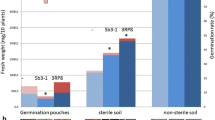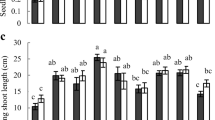Abstract
The Pythium biocontrol features of 17 Paenibacillus strains, all previously isolated from the rhizosphere, hyphosphere or bulk soil from mycorrhizal and non-mycorrhizal cucumber plants, were examined using a cucumber seedling emergence bioassay. Thirteen strains – four strains of Paenibacillus polymyxa, eight strains of P. macerans and one strain of Paenibacillus sp. – significantly increased the percentage of seedling emergence of seeds inoculated with agar plugs of Pythium aphanidermatum FC42. Overall, the efficacy of Pythium biocontrol did not seem to differ between isolates of Paenibacillus originating from either mycorrhizal or non-mycorrhizal systems. No strains significantly reduced the damping-off incidence caused by the aggressive isolate Pythium sp. B5. Two strains of P. macerans not only reduced the incidence of pre-emergence damping-off by 73%, but they also counteracted the plant growth-depressing effect of P. aphanidermatum FC42, so that 68–82% of the emerged seedlings remained healthy 7 days after sowing. Two strains of P. macerans and one strain of P. polymyxa also significantly increased the percentage of seedling emergence following inoculation with approximately 105 zoospores of P. aphanidermatum FC42. There was no significant difference between the dry weight of three selected bacteria-inoculated and -uninoculated plants in the absence of Pythium; however, the dry weight of bacteria-inoculated plants was significantly higher than that of the uninoculated control plants with bacteria in the presence of P. aphanidermatum FC42.


Similar content being viewed by others
References
Abbasi PA, Lazarovits G (2006) Seed treatment with phosphonate (AG3) suppresses Pythium damping-off of cucumber seedlings. Plant Dis 90:459–464
Appiah AA, van West P, Osborne MC, Gow NAR (2005) Potassium homeostasis influences the locomotion and encystment of zoospores of plant pathogenic oomycetes. Fungal Genet Biol 42:213–223
Azcón-Aguilar C, Barea JM (1996) Arbuscular mycorrhizas and biological control of soil-borne plant pathogens – an overview of the mechanisms involved. Mycorrhiza 6:457–464
Bae DW, Lee JT, Son DY, Lee ES, Kim HK (2000) Isolation of bacterial strain antagonistic to Pyricularia oryzae and its mode of antifungal action. J Microbiol Biotechnol 10:811–816
Bianciotto V, Bandi C, Minerdi D, Sironi M, Tichy HV, Bonfante P (1996) An obligately endosymbiotic mycorrhizal fungus itself harbors obligately intracellular bacteria. Appl Environ Microbiol 62:3005–3010
Budi SW, van Tuinen D, Martinotti G, Gianinazzi S (1999) Isolation from the Sorghum bicolor mycorrhizosphere of a bacterium compatible with arbuscular mycorrhiza development and antagonistic towards soilborne fungal pathogens. Appl Environ Microbiol 65:5148–5150
Christensen H, Jakobsen I (1993) Reduction of bacterial growth by a vesicular-arbuscular mycorrhizal fungus in the rhizosphere of cucumber (Cucumis sativus L.). Biol Fertil Soils 15:253–258
Citernesi AS, Fortuna P, Filippi C, Bagnoli G (1996) The occurrence of antagonistic bacteria in Glomus mosseae pot cultures. Agronomie 16:671–677
Fravel DR (1988) Role of antibiosis in the biocontrol of plant diseases. Annu Rev Phytopathol 26:75–91
Georgakopoulos DG, Fiddaman P, Leifert C, Malathrakis NE (2002) Biological control of cucumber and sugar beet damping-off caused by Pythium ultimum with bacterial and fungal antagonists. J Appl Microbiol 92:1078–1086
Gravel V, Martinez C, Antoun H, Tweddell RJ (2005) Antagonist microorganisms with the ability to control Pythium damping-off tomato seeds in rockwool. BioControl 50:771–786
Guemori-Athmani S, Berge O, Bourrain M, Mavingui P, Thiery JM, Bhatnagar T, Heulin T (2000) Diversity of Paenibacillus polymyxa populations in the rhizosphere of wheat (Triticum durum) in Algerian soils. Eur J Soil Biol 36:149–159
Hickman CJ (1970) Biology of Phytophthora zoospores. Phytopathology 60:1128–1135
Jones SW, Donaldson SP, Deacon JW (1991) Behaviour of zoospores and zoospore cysts in relation to root infection by P. aphanidermatum New Phytol 117:289–301
Keen NT, Yoshikawa M (1983) Physiology of disease and the nature of resistance to Phytophthora. In: Erwin DC, Bartnicki-Garcia S, Tsao PH (eds) Phytophthora: Its biology, taxonomy, ecology and pathology. American Phytopathological Society, St. Paul, pp 279–287
Larsen J, Ravnskov S, Jakobsen I (2003) Combined effect of an arbuscular mycorrhizal fungus and a biocontrol bacterium against Pythium ultimum in soil. Folia Geobot 38:145–154
Mansfeld-Giese K, Larsen J, Bødker L (2002) Bacterial populations associated with mycelium of the arbuscular mycorrhizal fungus Glomus intraradices. FEMS Microbiol Ecol 41:133–140
Meyer JR, Linderman RG (1986) Selective influence on populations of rhizosphere or rhizoplane bacteria and actinomycetes by mycorrhizas formed by Glomus fasciculatum. Soil Biol Biochem 18:191–196
Poole EJ, Bending GD, Whipps JM, Read DJ (2001) Bacteria associated with Pinus sylvestris-Lactarius rufus ectomycorrhizas and their effects on mycorrhiza formation in vitro. New Phytol 151:743–751
Rosendahl CN, Olson LW (1992) An in vivo screening method for antifungal activity against the plant pathogen Pythium ultimum Trow. J Phytopathol 134:324–328
Rosendahl CN, Rosendahl S (1990) The role of vesicular-arbuscular mycorrhiza in controlling damping-off and growth reduction in cucumber caused by Pythium ultimum. Symbiosis 9:363–366
Ryu CM, Kim J, Choi O, Park SY, Park SH, Park CS (2005) Nature of a root-associated Paenibacillus polymyxa from field-grown winter barley in Korea. J Microbiol Biotechnol 15:984–991
Salerno MI, Lori GA, Gimenez DO, Gimenez JE, Beltrano J (2000) Use of soil solarization to improve growth of eucalyptus forest nursery seedlings in Argentina. New For 20:235–248
Secilia J, Bagyaraj DJ (1987) Bacteria and actinomycetes associated with pot cultures of vesicular-arbuscular mycorrhizas. Can J Microbiol 33:1069–1073
St-Arnaud M, Hamel C, Caron M, Fortin JA (1994) Inhibition of Pythium ultimum in roots and growth substrate of mycorrhizal Tagetes patula colonized with Glomus intraradices. Can J Plant Pathol 16:187–194
Timmusk, S (2003) Mechanism of action of the plant growth promoting bacterium Paenibacillus polymyxa. PhD thesis, Uppsala University, Sweden
Timmusk S, Nicander B, Granhall U, Tillberg E (1999) Cytokinin production by Paenibacillus polymyxa. Soil Biol Biochem 31:1847–1852
Toljander JF, Artursson V, Paul LR, Jansson JK, Finlay RD (2006) Attachment of different soil bacteria to arbuscular mycorrhizal fungal extraradical hyphae is determined by hyphal vitality and fungal species. FEMS Microbiol Lett 254:34–40
von der Weid I, Paiva E, Nobrega A, van Elsas JD, Seldin L (2000) Diversity of Paenibacillus polymyxa strains isolated from the rhizosphere of maize planted in Cerrado soil. Res Microbiol 151:369–381
Walley FL, Germida JJ (1996) Failure to decontaminate Glomus clarum NT4 spores is due to spore wall-associated bacteria. Mycorrhiza 6:3–49
Wester E, Jensen DF, Moller D (1991) Anatomical studies of cucumber roots inoculated with Pythium zoospores. In: Beemster ABR, Bollen GJ, Gerlagh M, Ruissen MA, Shippers B, Tempel A (eds) Biotic interactions and soilborne diseases. Proc 1st Conf Eur Foundation Plant Pathol. Elsevier Science Publ, Amsterdam, pp 401–407
Whipps JM (2001) Microbial interactions and biocontrol in the rhizosphere. J Exp Bot 52:487–511
Whipps JM (2004) Prospects and limitations for mycorrhizas in biocontrol of root pathogens. Can J Bot 82:1198–1127
Wulff EG, Pham ATH, Cherif M, Rey P, Tirilly Y, Hockenhull J (1998) Inoculation of cucumber roots with zoospores of mycoparasitic and plant pathogenic Pythium species: Differential zoospore accumulation, colonization ability and plant growth response. Euro J Plant Pathol 104:69–76
Yang J, Kharbanda PD, Mirza M (2001) Evaluation of Paenibacillus polymyxa PKB1 for biocontrol of Pythium disease of cucumber in a hydroponic system. Can J Plant Pathol 23:191
Acknowledgements
The work was supported by the Sino-Danish Scientific and Technological Cooperation New Project Proposal for 14th Session (2004–2006; Granted No. AM14: 33). Tina Tønnersen is thanked for excellent technical assistance. Dr. Gary D. Bending is thanked for providing us with Paenibacillus sp. EJ P73.
Author information
Authors and Affiliations
Corresponding author
Rights and permissions
About this article
Cite this article
Li, B., Ravnskov, S., Xie, G. et al. Biocontrol of Pythium damping-off in cucumber by arbuscular mycorrhiza-associated bacteria from the genus Paenibacillus . BioControl 52, 863–875 (2007). https://doi.org/10.1007/s10526-007-9076-2
Received:
Accepted:
Published:
Issue Date:
DOI: https://doi.org/10.1007/s10526-007-9076-2




